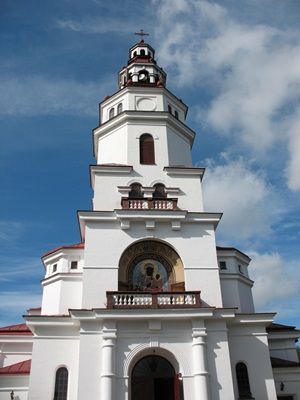Church of the Black Madonna of Częstochowa and St. Casimir the Prince in Mońki
Church of the Black Madonna of Częstochowa and St. Casimir the Prince in Mońki has a short, but turbulent history. The parish in a newly created and permanently developing railway settlement was established in 1920. The first bricked temple erected in Mońki was the Chapel of St. Casimir, connected to the parsonage. This was the place where holy masses were to take place until the end of the construction of the church. Bricks from the demolition of tsarist barracks in Hornostaje were used to construct both the chapel and the church some time later; the parishioners transported them on wagons to the construction site. Kazimierz and Wiktor Mońko devoted their land for the construction of the church and founding of a burial cemetery, located on a high sandy hill in the centre of the settlement. The brickwork started in 1923, according to a design of a popular architect Stefan Szyller, author of the church in Zachęta district, Warsaw for example. The new church, which its creator styled as a Renaissance-Baroque structure, was an impressive building with a short, but wide aisle corps, crossed by an even wider transept with a ‘Renaissance’ dome in its centre, hidden entirely in the roof construction. A massive, multi-storey tower situated in front of the facade, covered with an impressive dome with a gloriette, dominated over the church. The temple was finished in 1935 due to the efforts of all parishioners. They did not, however, enjoy the new temple for very long. At the end of June 1941 the retreating Russian army bombed the church with heavy cannons. The roof was destroyed, walls damaged and the enormous tower – according to the rector’s words – wobbled under the blows of the wind. So the parishioners from Mońki resumed their work and in November 1941 they finished the renovation of the church. It wasn’t the end of their efforts, though. On 11th July 1944 the retreating soldiers, this time the Germans, blew up the church, destroying it to the foundation.
In 1946, before rebuilding of the parish temple, the Chapel of St. Casimir was renovated and expanded, as it was to serve as a temporary parish church. Architect Marian Sordyl was asked to design the building, and he, using the preserved drawings of Szyller, created almost an exact copy of the demolished church. It was built on the well preserved foundations of the previous temple in less than a decade (1958-1966).
The church in Mońki is a three-aisle basilica with a short transept, to the gable walls of which walls low chapels are adjacent. A straight-enclosed chancel is annexed to the western elevation, along with two auxiliary rooms. Over the facade there is a massive belfry, quadrilateral in the lower storeys and octagonal in the higher. Its dome is surmounted with two gloriettes adorned with spheres on pedestals. The interior, divided into aisles with massive pillars, is covered with a groin vault. Above the intersection of the aisles we can see a cavetto vault stretched out. It replaced a dome which was difficult to built. The walls and vaults are entirely covered with a colourful polychrome, created in the Renaissance style in the 1970s by painters and art conservators: Władysława Kamińska-Tiunin, Konstanty Tiunin, Marek Karp and Robert Stpiczyński. The equipment of the church (Neo-Baroque altars, organ) dates back to the 1960s.
Opposite the church we can see the Chapel of St. Casimir linked to a one-storey parsonage.

In 1946, before rebuilding of the parish temple, the Chapel of St. Casimir was renovated and expanded, as it was to serve as a temporary parish church. Architect Marian Sordyl was asked to design the building, and he, using the preserved drawings of Szyller, created almost an exact copy of the demolished church. It was built on the well preserved foundations of the previous temple in less than a decade (1958-1966).
The church in Mońki is a three-aisle basilica with a short transept, to the gable walls of which walls low chapels are adjacent. A straight-enclosed chancel is annexed to the western elevation, along with two auxiliary rooms. Over the facade there is a massive belfry, quadrilateral in the lower storeys and octagonal in the higher. Its dome is surmounted with two gloriettes adorned with spheres on pedestals. The interior, divided into aisles with massive pillars, is covered with a groin vault. Above the intersection of the aisles we can see a cavetto vault stretched out. It replaced a dome which was difficult to built. The walls and vaults are entirely covered with a colourful polychrome, created in the Renaissance style in the 1970s by painters and art conservators: Władysława Kamińska-Tiunin, Konstanty Tiunin, Marek Karp and Robert Stpiczyński. The equipment of the church (Neo-Baroque altars, organ) dates back to the 1960s.
Opposite the church we can see the Chapel of St. Casimir linked to a one-storey parsonage.













